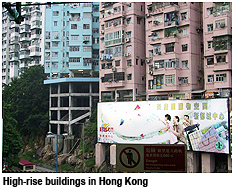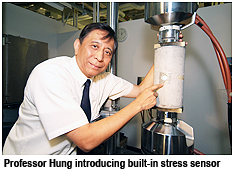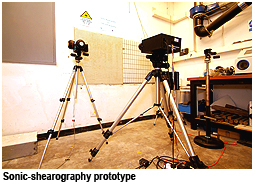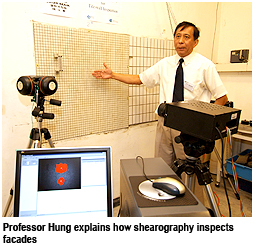Torrential rains in August have caused a number of landslides that undermine building foundations and increase the risk of catastrophic building collapse and falling wall tiles.
There are over 50,000 high-rise buildings (exceeding 100 meters) prone to problems of aging, deterioration, typhoons and short pilings in Hong Kong. These buildings are designed for a life cycle of 50 years. Chair Professor Michael Hung of the Department of Manufacturing Engineering and Engineering Management said, “High-rise buildings constructed on steep slopes are especially vulnerable during rainy seasons when foundations are weakened by landslides.”
Current methods of surface checks, tapping or testing a few concrete samples are inadequate to detect faults in buildings. The results are always unreliable and are prone to human error. Professor Hung has developed two novel technologies, known as “crystal sensor” and “shearography”, that detect structural defects and unstable tiles, respectively. These innovations in the field of building inspection demonstrate CityU academics’ excellence in applied research and their proactive response to social concerns.
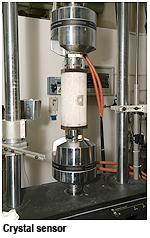
“The key to building safety is prevention through regular inspection and continuous health monitoring,” Professor Hung stressed. The crystal sensor is a built-in stress sensor made of crystal that once embedded in structures monitors building safety over the long-term. Any changes in stress induce changes in the crystal’s colour can act as an early warning system. By setting up computer equipment to collect and analyse the data generated by the sensor, researchers can evaluate stress level in building structures, thus ensuring safety.
Combining his invention, “shearography” and sonic technology, Professor Hung has developed a speedy technique to inspect the tile facades in buildings.
Currently the technique can inspect a surface area of one square meter in two seconds at a time. Professor Hung originally aspired to develop holography for industrial applications. Holography won the late Professor Dennis Gabor a Nobel Prize, but the technique could not work under the noisy and unstable conditions in factories. This prompted Professor Hung to develop shearography.
Shearography is a novel optical sensing technique that uses a laser-speckle pattern to provide full-field measurement of surface deformation. Like the
conventional non-destructive ultrasonic technique, shearography does not destroy the integrity of the object tested. But it is 1,000 times faster and does not require coupling a transducer to the object’s surface with fluid. Shearography has been specified by the US Federal Aviation Administration for inspecting aircraft tyres. NASA has also used this technique to test aerospace structures. The technology also has wide potential application inspecting bridges, airports, dams, power plants, mass transit railway and other infrastructures.
